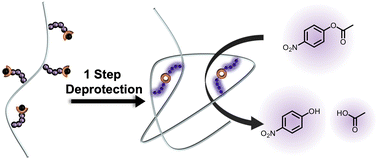The folding of synthetic polymers into single chain nanoparticles draws inspiration from the folding of polypeptides into the functional macromolecular architectures of proteins. The building blocks of their natural inspiration, amino acids and peptides, are surprisingly underutilised in the design of synthetic folded architectures. Based on N-terminal cysteines, methylmethacrylate derived monomers were designed that are readily copolymerizable with PEGMA and MMA to provide water soluble polymer-peptide conjugates. Upon acidic deprotection of the peptide side chains, disulphide bridges crosslink the parent polymer into a folded architecture. Providing access to functional folded macromolecular architectures, the presented synthetic strategy allows for a facile incorporation of functional amino acid sequences. Embedding of the catalytic triad into pentapeptides containing N-terminal cysteines enabled a one step folding and activation of their catalytic activity as exemplified by hydrolysis of para-nitrophenylacetate.
